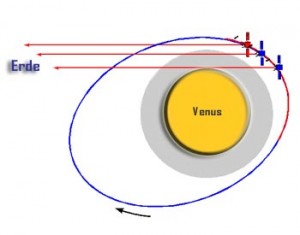VeRa – Venus Express Radio Science

The direct radio contact between spacecraft and the ground station on Earth is used for the radio sounding of neutral and media.
The scientific aims of the Venus Radio Science Experiment (VeRa) are:
(1) Radio sounding of Venus’ ionosphere,

from ~ 80 km altitude to the ionopause (300 km to 600 km altitude depending of the state of the solar wind), in dependence of planetary latitude and solar wind to:
- deduce vertical profiles of the electron density,
- determine the height of the ionopause,
- study the interaction of the solar wind with Venus' ionosphere as a function of local time
(2) Radio sounding of the neutral atmosphere from the cloud cover (35 – 40 km) up to 100 km altitude to deduce vertical profiles of the neutral mass density, the temperature and the pressure in dependence of the planetary latitude and the season as functions of local time.

(3) Measurements of the electric features,
roughness and chemical composition of Venus’ surface using the reflection of radio waves on the surface (bistatic radar experiment),
(4) Studies of the coronal structure and the solar wind turbulence during the upper and the lower conjunction of Venus around the Sun. For terrestrial planets one distinguishes between upper and lower conjunction, i.e. the planet resides on a line: planet-Sun-Earth (upper conjunction) or Sun-planet-Earth (lower conjunction).
VeRa uses the radio carrier signal of the spacecraft in the X-band (8.4 GHz) and in the S-band (2.3 GHz) which are transferred simultaneously by the high gain antenna (HGA).